Menus
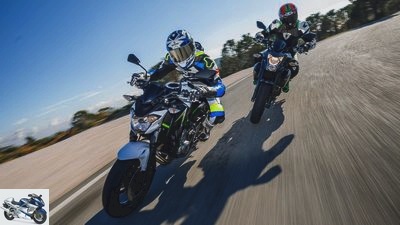
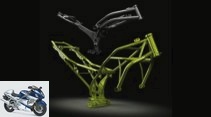
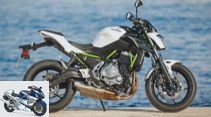
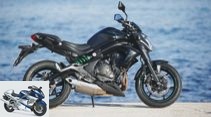
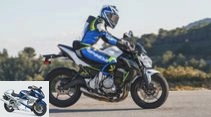
34 photos

1/34
Kawasaki Z 650 and Kawasaki ER-6n in comparison test.
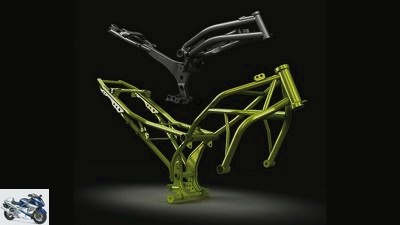
Kawasaki
2/34
Diet: The tubular space frame of the Z 650 saves ten kilos. The motor must now also contribute to the rigidity
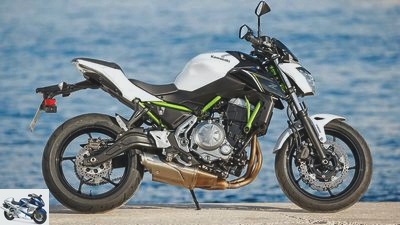
3/34
Black on white: the frame and the central instead of the side-mounted suspension strut distinguish the Z 650 and…
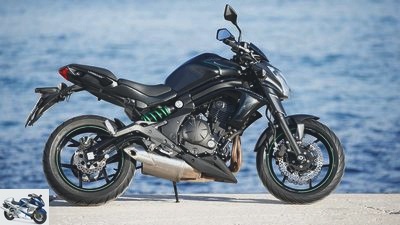
4/34
…ER-6n at first sight.
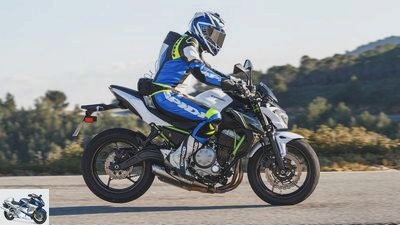
5/34
Kawasaki Z 650 in comparison test
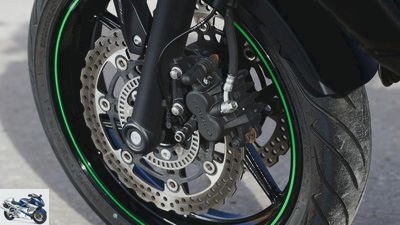
6/34
Kawasaki ER-6n in comparison test
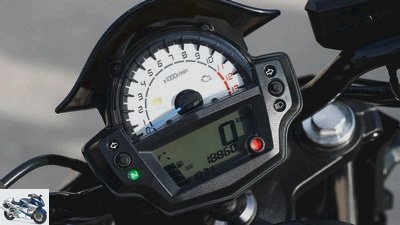
7/34
Fully analog tachometer in the ER-6n.
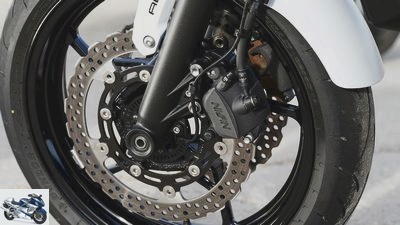
8/34
Wait a minute: the Nissin brakes of the Z 650, which come from the Versys 650, bite more powerfully and more easily into the visually striking wave brake discs

9/34
Analog tachometer with digital pointer in the Z 650. That remains a matter of taste. The gear display pleases in any case
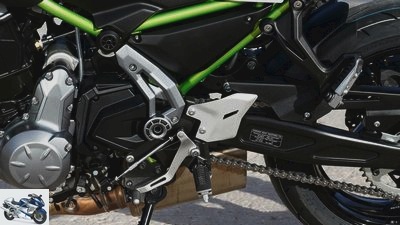
10/34
To the front: Anyone who uses the swing arm pivot point as an orientation aid will see that the driver’s footrests of the Z 650…

11/34
…are positioned 60 millimeters further forward than on the ER-6n
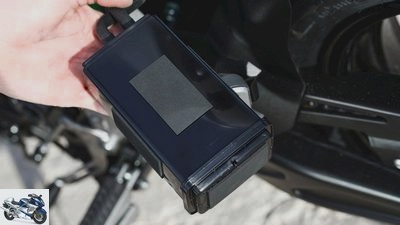
12/34
Activated carbon filter: In addition to stricter exhaust gas limit values, the Euro 4 homologation also requires the introduction of the tank ventilation into an activated carbon filter.
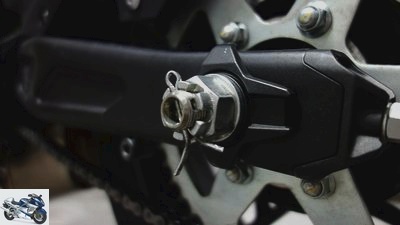
13/34
Cotter pin: Previously ridiculed, now cult: the cotter pin on the rear axle of (almost) all Kawa bikes. On the Z 650 it is covered by a rubber hood.
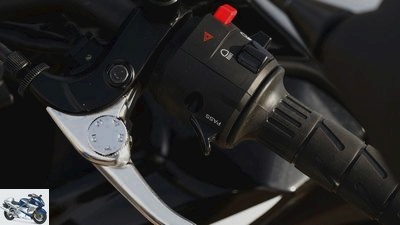
14/34
Clutch lever: With brakes and hydraulically operated clutches, hand levers with adjustable reach are common. This is not always the case with clutches activated by cable pull. The Z has it. Great praise. Especially in this price range.
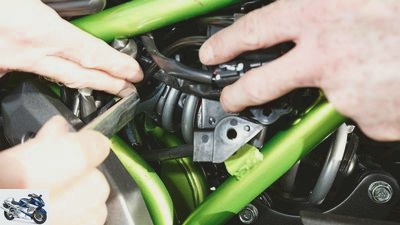
15/34
Spring base: Even three hands are not enough to reach the almost inaccessible adjustment ring on the spring base. The reason: The shock absorber comes unchanged from the ER-6n and can therefore not be installed the other way around.
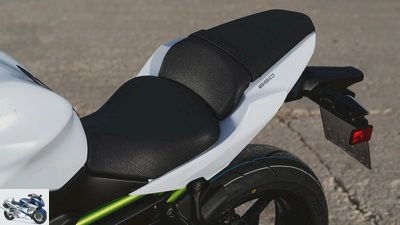
16/34
…Good to see: The Z-650 passenger has to suffer
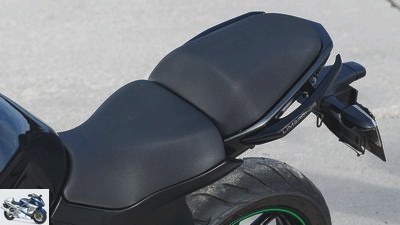
17/34
Not to be seen: the narrower and thinner driver’s seat offers hardly less comfort than the massive ER-6n cushion…
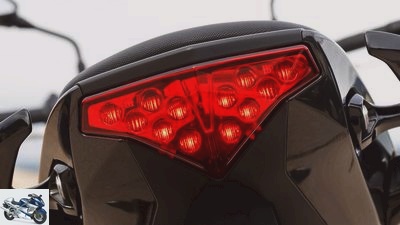
18/34
Kawasaki ER-6n in comparison test
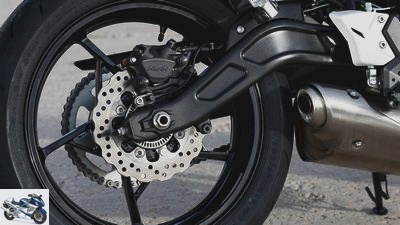
19/34
Because of the banana: The new steel box swing arm of the Z 650 saves 2.8 kilos compared to that…
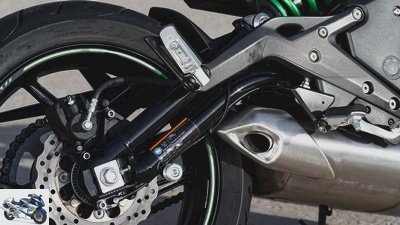
20/34
…the double tube variant in the ER-6. The old one was visually more striking
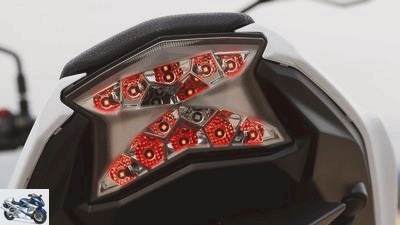
21/34
I have a big name: The legendary Z also carries the new one at the rear. The commitment to great history formulated by LED bulbs is original
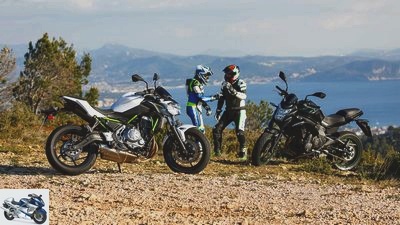
22/34
Kawasaki Z 650 and Kawasaki ER-6n in comparison test.
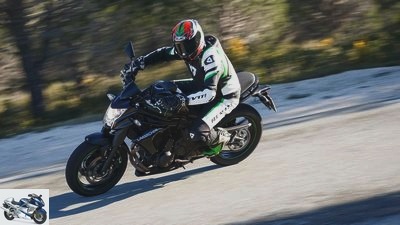
23/34
Kawasaki Z 650 and Kawasaki ER-6n in comparison test.

24/34
Kawasaki Z 650 and Kawasaki ER-6n in comparison test.
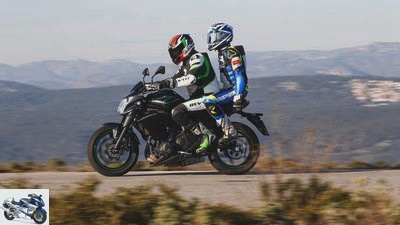
25/34
Kawasaki Z 650 and Kawasaki ER-6n in comparison test.
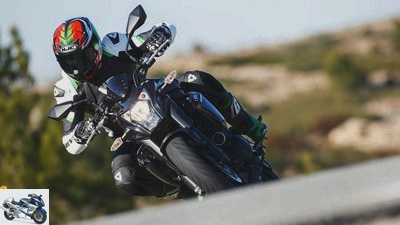
26/34
Kawasaki Z 650 and Kawasaki ER-6n in comparison test.
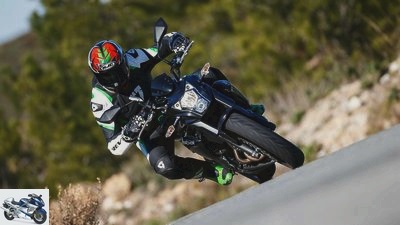
27/34
Kawasaki Z 650 and Kawasaki ER-6n in comparison test.
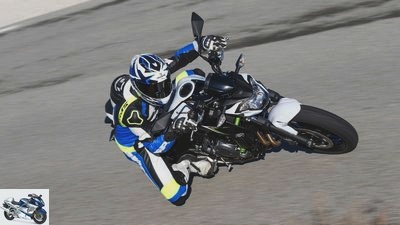
28/34
Kawasaki Z 650 and Kawasaki ER-6n in comparison test.

29/34
Kawasaki Z 650 and Kawasaki ER-6n in comparison test.
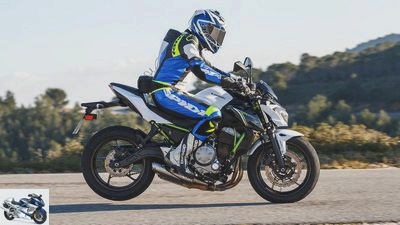
30/34
Kawasaki Z 650 and Kawasaki ER-6n in comparison test.
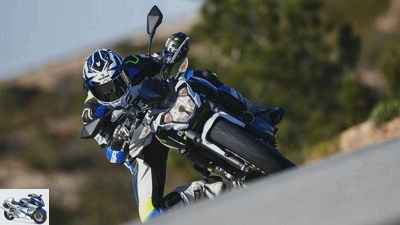
31/34
Kawasaki Z 650 and Kawasaki ER-6n in comparison test.
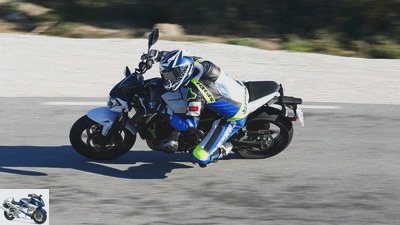
32/34
Kawasaki Z 650 and Kawasaki ER-6n in comparison test.
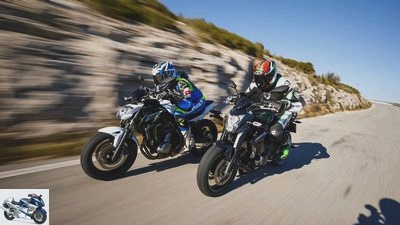
33/34
Kawasaki Z 650 and Kawasaki ER-6n in comparison test.
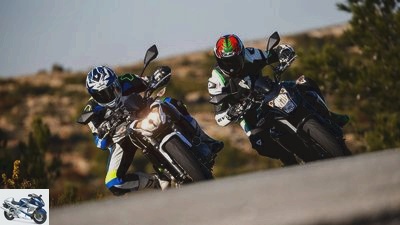
34/34
Kawasaki Z 650 and Kawasaki ER-6n in comparison test.
Kawasaki Z 650 and Kawasaki ER-6n in comparison test
Working class heroes
The Kawasaki Z 650 is the successor to the mid-range top seller ER-6n. Does the small Z strike other notes? The comparative top test will show.
So many top sellers could get jealous. From its launch in 2006 until last season, the Kawasaki ER-6 has been one of the five best-selling motorcycles in Germany. Only one other machine achieved this in the same period: the long-running BMW R 1200 GS. And now? Becomes the E.R-6n the Z 650. The new name follows the logic of the Kawasaki model nomenclature. In addition to the Z 1000 and the new Z 900, the popular working-class hero now rounds off the Kawasaki naked bike range. But the abbreviation Z signals even more. With the headlights pulled down, the rear end rising and angular contours, the brave mid-range bike also takes up the design language of its bigger sisters. End with honest man, bring the arsonist? In this top test, the ER-6n will constantly flicker in the rearview mirror of the newcomers and help to classify the reorientation within the family.
Buy complete article

Kawasaki Z 650 and Kawasaki ER-6n in comparison test
Working class heroes
Z 650 have slimmed down. 19 kilograms? You read that right. The new one even weighs 20 kilos less on the MOTORRAD scale, weighing 188 instead of 208 kilos. Incredible. The new frame and swing arm alone save almost 13 kilos. The rest of the fat layer is reduced by the lighter wheels and brakes, the two kilos lighter engine housing and the more delicate plastic parts. The tank capacity, which has been reduced from 16 to 15 liters, contributes just under a kilo.
With its new sports figure, the Z throws itself proudly and energetically into the first corners. The front-facing seating position puts more pressure on the front wheel, the steering head, which is half a degree (65.5 instead of 65 degrees) steeper, and the caster that has been reduced by ten to 100 millimeters add more agility to the steering. Together with the Radical Diet, the Lighter Life Package adds up to a livelier and more precise driving experience every time you bend. The Z tilts playfully, cuts precisely and cleanly along the radius. By the way: The enormous freedom of inclination of the ER-6n base does not limit the lower mounted footrests on the Z 650 significantly. As before, if it scratches in solo operation, sloping will soon become flat. Not even the original tires, which in the past often gave the Z models from Kawasaki an idiosyncratic steering behavior, tarnish the successful appearance. The Dunlop D 214 steer neutrally and stick properly. The pelts weaken only with feedback and wet grip.
Sponge over it, because the Baby-Z also makes its predecessor look old between the arches. The new Elan is probably not solely attributable to the medium speed range, which has been moderately strengthened with the usual means (reduced throttle valve diameter, tamer valve timing). It is more of a combination of the slim line and the more spontaneous use of power with which the Z 650 sets the scene. As if the technicians had implanted a shorter gear ratio, the Z 650 sprints away at every corner exit. Regardless of whether it is the parallel sprint from the corners in the lower gears or the pulling through in sixth gear for the MOTORRAD performance – the new one always makes the dust. The new ER-6n takes two seconds – with the same gear ratio, mind you – when it sprints from 60 to 140 km / h.
However: the sleek appearance requires sacrifices. Above 7000 revolutions – and this speed range is still relevant in practice for a 650 series – the Z-propellant must be able to be surpassed by the ER engine. It is not so much the four horses that the 68 HP Z-unit loses on the 72 HP ER engine at the top. What is more astonishing is that the pressure of the Z 650 flattens out at 8000 rpm and is finally stalled by the rev limiter at 9500 rpm. Is it because of the stricter exhaust gas limits of the Euro 4 standard? Might be. Because the mechanically largely identical ER-6n-Twin is allowed to turn 10 800 rpm. Ultimately, the slowed-down revving is also the reason why the 191 km / h Z is missing nine kilometers on the 200 km / h top speed of the ER. For those who want to know: the naked duo still runs straight ahead at these tempos without blame or blame. The chassis geometry of the Z 650, which is geared towards better handling, does not change anything.
Admittedly, top speed is not a central issue for naked bikes. Other values count on the country road. In addition to handling and pressure, especially the suspension. The ER-6n has never been covered with fame here. Above all, the shock absorber gives hard edges to the pilot. And now? If the monoshock, which was previously hinged on the side, moves to the center of the frame on the Z 650 and – as with the large Zetts – is activated via a deflection. At the front, softer springs (15 instead of 17.5 N / mm spring rate) soften the fork. In theory, this could bring additional convenience. In practice, however, there is no progress. Despite the progressive acting rocker arm, the Z-650 tail sucks neither small waves nor larger heels away better than the hindquarters of the ER-6n. The modified fork responds well, but dips deeper when braking hard than its counterpart in the ER-6n. There are no adjustment options – apart from the spring base of the monoshock. As is usually the case in this price league. The faster the swing, the more excited it pumps itself through the spring travel with the reduced damping at both the front and rear. Especially against the background of the overall sportier orientation of the Z, this tuning is surprising.
After all, for this very reason she would have been forgiven for the ego trip. Not much of the passenger comfort of the ER-6 with its wide seat cushion and sturdy handles has remained with the Z 650. A narrow seat roll without holding troughs and the high-mounted passenger pegs degrade the back seat of the Z to an emergency seat à la super sports car.
She could take a tight passenger, at least when it comes to braking. Compared to the Tokico stoppers of the ER-6n, the Nissin pliers of the Z from the Versys 650 bite more powerfully and more easily into the wave brake discs. In an emergency, the further developed Bosch ABS also regulates more finely than its predecessor in the ER-6n.
Shared happiness is double happiness? At least the time seems to pass twice as fast. Turn to the gas station. The Z decides the fuel nozzle duel for itself. 4.0 to 4.2 liters at 100 km / h. The Z almost compensates for its smaller fuel tank in terms of range. It’s amazing that so little fuel makes so much driving fun possible. Especially since moderation is also popular in terms of price. With 6920 euros (including ancillary costs), Kawasaki calls for a moderate 300 euros more for the retreaded. The fact that the pecuniary stranglehold is probably due to the suspension tuning that can be optimized, the letters of the law possibly the motor that is short of breath at the top and the sporting orientation are certainly due to the ignorance towards the passenger, must be accepted in the new one. And it can too. Because with the bikini diet, the lively start, the more agile handling and the accurate steering behavior, the newcomer has more trumps on hand. Or to put it very simply: The Z 650 is the better ER-6n.
MOTORCYCLE conclusion
The name is program. In the metamorphosis from the ER-6 to the Z 650, the top seller follows the trail of the sporty Z-model series from Kawasaki. More agile handling, a more powerful engine, better brakes and – above all – the 20 kg diet give the Z a noticeably fresh note. The reduced revving and the moderate suspension may cast a shadow over the sports figure – for less than 7,000 euros, the Z 650 is and remains a great offer.
Related articles
-
Kawasaki Ninja 300 and KTM RC 390 in the test
31 photos 1/31 KTM RC 390. 2/31 Comparison test Kawasaki Ninja 300 and KTM RC 390. 3/31 Comparison…
-
Comparison test: 250cc motocross
Motociclismo comparison test: 250-cm3-Motocross 2011 The revised 250-cm³-Crosser in comparison Anyone who does not differ from their colleagues in motocross …
-
Comparison test of naked bikes
Naked bike comparison test 2011: Ducati, Kawasaki and Triumph The triumph of the new Speed Triple content from Triumph strikes back. After this…
-
Triumph Tiger 1050 Sport against Kawasaki Z 1000 SX in comparison test
17th photos 1/17 Comparison test between Kawasaki Z 1000 SX and Triumph Tiger 1050 Sport. 2/17 Faster wheel…
-
Kawasaki ER-6n and KTM 690 Duke in comparison
14th photos 1/14 Two middle class naked bikes in the verifying test. In the end, who is ahead of the game – the Kawasaki ER-6n…
-
Gargolov 20th photos Kawasaki 1/20 Kawasaki 2/20 Kawasaki 3/20 Kawasaki 4/20 Kawasaki 5/20 Kawasaki 6/20 Kawasaki 7/20 Kawasaki 8/20 Kawasaki 9/20…
-
Kawasaki Z 800 in the top test
j.kuenstle.de 15 pictures 1/15 The Kawasaki Z 800 is the successor to the Z 750 and in the MOTORRAD top test. 2/15 Wheelie with the …
-
BMW, Ducati, Suzuki and Triumph super sports cars in a comparison test
29 photos 1/29 Triumph Daytona 675, Ducati 848 Evo Corse SE, BMW S 1000 RR, Suzuki GSX-R 750. Different bikes – different cubic…
-
Kawasaki Z 800 versus Yamaha FZ8 in MOTORCYCLE group test
12th photos 1/12 Yamaha FZ8 versus Kawasaki Z800 in comparison test. 2/12 Clearly structured cockpit, but with…
-
Jahn Top test Kawasaki ZX-12R ZX-12Air With its 175 hp engine, Kawasaki’s green racer bridges distances as if in flight and, if necessary, pushes the…